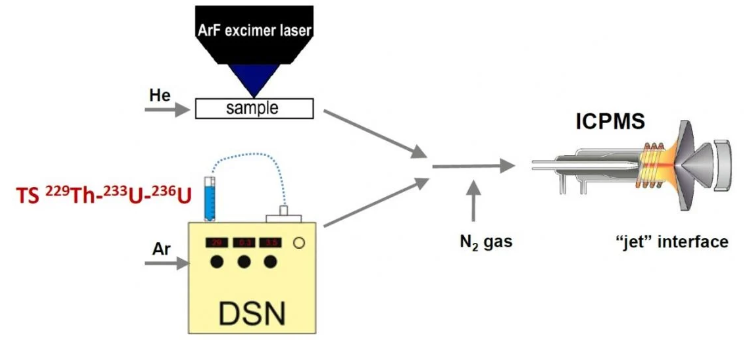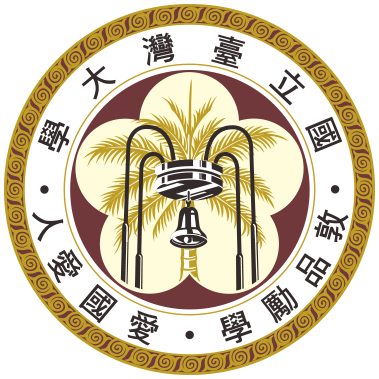Dr. Chung-Che Wu, a Ph.D. graduate from the Department of Geosciences, National Taiwan University (NTU), along with Prof. Chuan-Chou Shen, the National Chair Professor, collaborating with an international research team from the Swiss Federal Institute of Technology (ETH), Switzerland, published a cutting-edge laser-ablation uranium-thorium dating (LA U-Th dating) technology in the prestigious journal "Analytical Chemistry" on August 6th (1) and was selected as one of the cover articles. This breakthrough technology improved LA U-Th dating limits to within tens of thousands of years, with the youngest geological samples dated to only a thousand years, making it the most advanced analytical technique internationally.
U-Th dating is a method used to determine rock formation age by analyzing the ratios of daughter isotope (230Th) to parent isotopes (238U and 234U). This dating system covers a range from several years to six or seven hundred thousand years (Shen et al., 2012, Geochimica et Cosmochimica Acta; Cheng et al., 2013, Earth and Planetary Science Letters), and it is widely applied across various fields of Earth science. However, it is the most complex dating system as it involves four unstable isotopes, 238U, 234U, 232Th, and 230Th. For most commonly used samples of limestone, rare quantity amounts of 238U presents from 10-8 to 10-6 g/g, trace amounts of 234U ranging from 10-12 to 10-10 g/g, extremely trace amounts of 230Th ranging from 10-18 to 10-14 g/g, and variable 232Th content. Moreover, throughout the entire experimental process, the containers and chemicals contain these isotopes, leading to unavoidable experimental contamination. Thus, it is difficult to accurately and precisely analyze these isotope ratios. Due to the complexity of theory and extremely high technical barriers, there are only a few word-clads U-Th dating laboratories worldwide.
In the High-precision Mass Spectrometry and Environment Change Laboratory (HISPEC), led by Prof. Shen, approximately 0.1-0.5 grams of subsample from polished rock surface are usually drilled for U-Th dating. Uranium and thorium are purified for instrumental analysis to earn high-precision isotope ratios. However, the limitations include the need for 1-cm subsampling points, complex chemical processing, and possible experimental contamination. Laser ablation-inductively coupled plasma mass spectrometry (LA-ICPMS) offers advantages of rapid, in-situ, and high spatial resolution analysis. Subsampling points are as small as tens of micrometers (µm), where tiny ablated particles are directly measured without the need for chemical processing. This technology has the advantages of small sampling and rapid analysis, but its low sensitivity, poor performance, and large errors greatly limit its applications, particularly for samples younger than a few thousand years.
Dr. Wu pointed out that the research team initially focused on instrumental improvements to increase the sensitivity to over 1%, which allows for the detection of more 230Th isotopes and thereby improves the dating precision. Three artificial isotopes, 229Th, 233U, and 236U, as tracers, were introduced to mix with the LA generated tiny sample particles, to ensure accuracy (Figure 1).

Figure 1. Schematic diagram of the experimental design of this study.
The highlight of this study is the breakthrough in surpassing the limits of previous LA methods, enabling the analysis of samples within tens of thousands of years. One of the key achievements is that this team can now successfully measure "young" geological samples as recent as one thousand years. This frontier technique is expected to be applied to diverse fields, such as paleoclimatology, oceanography, geomagnetism, anthropology, and environmental science.
Dr. Wu, as the first author and corresponding author of this study, earned his Ph.D. degree from the Department of Geosciences, NTU, in 2018. Supported by the Postdoctoral Fellowships Program of the Ministry of Science and Technology (108-2917-I-564-011), he worked as a postdoctoral researcher at the ETH, one of global top 10 universities, from 2019 to 2020. In 2020, he was then awarded a prestigious Marie Skłodowska-Curie Individual Fellowship (No. 891710) under the EU Horizon 2020 program, to continue developing this pioneering technology. This achievement also represents the Department of Geosciences, NTU, in cultivating world-class research talent.
Link to the paper: https://pubs.acs.org/doi/10.1021/acs.analchem.4c01114
Source: https://www.ntu.edu.tw/spotlight/2024/2294_20240828.html


